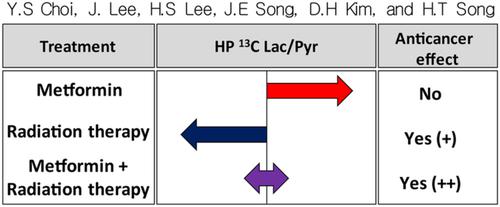当前位置:
X-MOL 学术
›
NMR Biomed.
›
论文详情
Our official English website, www.x-mol.net, welcomes your feedback! (Note: you will need to create a separate account there.)
Offset of apparent hyperpolarized 13C lactate flux by the use of adjuvant metformin in ionizing radiation therapy in vivo
NMR in Biomedicine ( IF 2.9 ) Pub Date : 2021-06-03 , DOI: 10.1002/nbm.4561 Young-Suk Choi 1 , Joonsung Lee 2, 3 , Han-Sol Lee 4 , Jae Eun Song 4 , Dong-Hyun Kim 4 , Ho-Taek Song 1
NMR in Biomedicine ( IF 2.9 ) Pub Date : 2021-06-03 , DOI: 10.1002/nbm.4561 Young-Suk Choi 1 , Joonsung Lee 2, 3 , Han-Sol Lee 4 , Jae Eun Song 4 , Dong-Hyun Kim 4 , Ho-Taek Song 1
Affiliation

|
An increase in hyperpolarized (HP) [1-13C]lactate production has been suggested as a biomarker for cancer occurrence as well as for response monitoring of cancer treatment. Recently, the use of metformin has been suggested as an anticancer or adjuvant treatment. By regulating the cytosolic NAD+/NADH redox state, metformin stimulates lactate production and increases the HP [1-13C]lactate conversion rate in the kidney, liver, and heart. In general, increased HP [1-13C]lactate is regarded as a sign of cancer occurrence or tumor growth. Thus, the relationship between the tumor suppression effect of metformin and the change in metabolism monitored by HP [1-13C]pyruvate MRS in cancer treatment needs to be investigated. The present study was performed using a brain metastasis animal model with MDA-MB-231(BR)-Luc breast cancer cells. HP [1-13C]pyruvate MRS, T2-weighted MRI, and bioluminescence imaging were performed in groups treated with metformin or adjuvant metformin and radiation therapy. Metformin treatment alone did not display a tumor suppression effect, and the HP [1-13C]lactate conversion rate increased. In radiation therapy, the HP [1-13C]lactate conversion rate decreased with tumor suppression, with a p-value of 0.028. In the adjuvant metformin and radiation treatment, the tumor suppression effect increased, with a p-value of 0.001. However, the apparent HP [1-13C]lactate conversion rate (Kpl) was observed to be offset by two opposite effects: a decrease on radiation therapy and an increase caused by metformin treatment. Although HP [1-13C]pyruvate MRS could not evaluate the tumor suppression effect of adjuvant metformin and radiation therapy due to the offset phenomenon, metabolic changes following only metformin pre-treatment could be monitored. Therefore, our results indicate that the interpretation of HP [1-13C]pyruvate MRS for response monitoring of cancer treatment should be carried out with caution when metformin is used as an adjuvant cancer therapy.
中文翻译:

在体内电离放射治疗中使用辅助二甲双胍抵消表观超极化 13C 乳酸通量
超极化 (HP) [1- 13 C]乳酸产生的增加已被建议作为癌症发生以及癌症治疗反应监测的生物标志物。最近,已建议使用二甲双胍作为抗癌或辅助治疗。通过调节细胞溶质 NAD + /NADH 氧化还原状态,二甲双胍可刺激乳酸产生并增加肾脏、肝脏和心脏中的 HP [1- 13 C]乳酸转化率。一般而言,增加的HP [1- 13 C]乳酸被认为是癌症发生或肿瘤生长的标志。因此,二甲双胍的肿瘤抑制作用与HP监测的代谢变化之间的关系[ 1-13C]丙酮酸MRS在癌症治疗中的作用需要研究。本研究使用具有 MDA-MB-231(BR)-Luc 乳腺癌细胞的脑转移动物模型进行。在用二甲双胍或辅助二甲双胍和放射治疗治疗的组中进行HP [1- 13 C]丙酮酸MRS、T 2加权MRI和生物发光成像。单独二甲双胍治疗未显示肿瘤抑制作用,并且HP [1- 13 C]乳酸转化率增加。在放射治疗中,HP [1- 13 C]乳酸转化率随着肿瘤抑制而降低,p值为0.028。在辅助二甲双胍和放射治疗中,肿瘤抑制作用增强,p-值为 0.001。然而,观察到明显的 HP [1- 13 C] 乳酸转化率 ( K pl ) 被两种相反的效果所抵消:放射治疗的减少和二甲双胍治疗引起的增加。尽管HP [1- 13 C]丙酮酸MRS由于抵消现象无法评估辅助二甲双胍和放射治疗的肿瘤抑制效果,但可以监测仅二甲双胍预处理后的代谢变化。因此,我们的结果表明,当二甲双胍用作癌症辅助治疗时,应谨慎解读 HP [1- 13 C]丙酮酸 MRS 以监测癌症治疗的反应。
更新日期:2021-07-02
中文翻译:

在体内电离放射治疗中使用辅助二甲双胍抵消表观超极化 13C 乳酸通量
超极化 (HP) [1- 13 C]乳酸产生的增加已被建议作为癌症发生以及癌症治疗反应监测的生物标志物。最近,已建议使用二甲双胍作为抗癌或辅助治疗。通过调节细胞溶质 NAD + /NADH 氧化还原状态,二甲双胍可刺激乳酸产生并增加肾脏、肝脏和心脏中的 HP [1- 13 C]乳酸转化率。一般而言,增加的HP [1- 13 C]乳酸被认为是癌症发生或肿瘤生长的标志。因此,二甲双胍的肿瘤抑制作用与HP监测的代谢变化之间的关系[ 1-13C]丙酮酸MRS在癌症治疗中的作用需要研究。本研究使用具有 MDA-MB-231(BR)-Luc 乳腺癌细胞的脑转移动物模型进行。在用二甲双胍或辅助二甲双胍和放射治疗治疗的组中进行HP [1- 13 C]丙酮酸MRS、T 2加权MRI和生物发光成像。单独二甲双胍治疗未显示肿瘤抑制作用,并且HP [1- 13 C]乳酸转化率增加。在放射治疗中,HP [1- 13 C]乳酸转化率随着肿瘤抑制而降低,p值为0.028。在辅助二甲双胍和放射治疗中,肿瘤抑制作用增强,p-值为 0.001。然而,观察到明显的 HP [1- 13 C] 乳酸转化率 ( K pl ) 被两种相反的效果所抵消:放射治疗的减少和二甲双胍治疗引起的增加。尽管HP [1- 13 C]丙酮酸MRS由于抵消现象无法评估辅助二甲双胍和放射治疗的肿瘤抑制效果,但可以监测仅二甲双胍预处理后的代谢变化。因此,我们的结果表明,当二甲双胍用作癌症辅助治疗时,应谨慎解读 HP [1- 13 C]丙酮酸 MRS 以监测癌症治疗的反应。



























 京公网安备 11010802027423号
京公网安备 11010802027423号